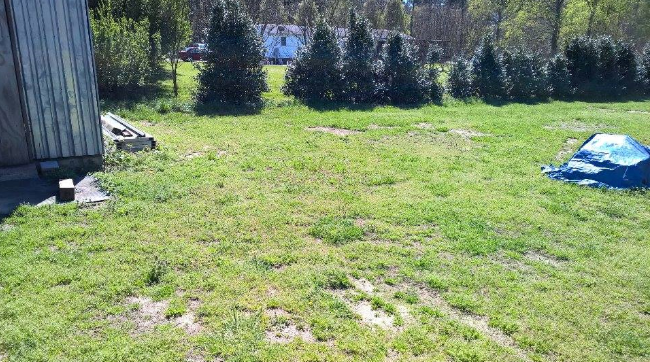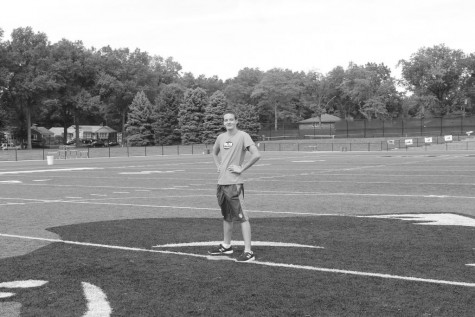The big break
Photo Credit: Jason Messenbrink
The backyard of Jacob’s house and the row of domestically grown trees where in the field just beyond I fell off
May 26, 2016
It’s March 4, 2016. It’s 7 P.M. and I’m inside of the Progressive Hand Therapy located in an apartment building in Westwood, NJ.
I’m doing my routine exercises- “canoe stretches”, which involve gripping the top of a bar with my right hand and applying pressure while placing my left hand underneath the bottom of the bar and executing a boat rowing like motion. Later I do ten “bench presses” where I lay on an exam table and lift the light bar up to stretch my arm. Followed by ten repetitions of rolling a ball up a wall and closing with two minutes of squeezing a sponge and two minutes of stretching my fingers by rolling a circular bar back and forth with my hand.
These exercises are intended to help stretch out the tendons in my hand, fingers, and wrist. The tendons are currently in the process of reaching their original stretched position.
My tendons are currently disabled as a result of nerve repositioning from a surgical operation that I endured to correct an earlier surgery that occurred directly after I broke my arm falling off of a golf cart.
The break
It was sometime before the beginning of my summer break, I was in third grade.
My friend Jacob and I, as well as my brother, were skateboarding at Jacob’s house. In addition to skateboarding, we were doing kickflips off a large white ramp that sat in Jacob’s yard.
We then came up with the idea to go to our friend Day Shawn’s house, which was simply a field away. According to Jacob, Day Shawn had an asphalt driveway, which was more appropriate for skateboarding.
Jacob and I boarded a golf cart and my brother hopped on his dirt bike.
We proceeded to drive through a row of neatly trimmed trees, serving as a divide between yards. Jacob took a hard left turn and I was propelled out of the cart.
I woke up on the ground groggy and disoriented on the ground.
“I was shocked,” Jacob said. “One minute you were there and then I turned to look at Tommy and when I looked back you were gone.”
One at a time I moved all four limbs. I checked my left leg, it moved, checked my right leg, it moved, checked me right arm, and it also moved, but it was when I attempted to move my left arm, which was right in front of me, that I realized something was very wrong.
I was then driven from Jacob’s house to the “Nash General Health Center” in Rocky Mount, NC.
My dad was working on the plant nursery that he owned on our property when he was notified of what had occurred, he called and told my mom about it and at about 6:00 pm I was in my hospital bed with Jacob’s parents, my brother, and my parents.
The surgery
On Dec. 27, I was laying in a hospital bed next to my parents and brother, looking at my left arm and thinking to myself that it would be the last time it would be in that physical state.
A nurse then came into the room to stick an IV into my right arm. After sticking the needle in my hand, she immediately noticed something was wrong. The needle was improperly positioned.
After a handful of nurses a doctor entered the room and correctly administered the IV.
About twenty-five minutes later another Anesthesiologist entered the room and briefly gave me a synopsis of what they were going to do. The surgeons planned to activate a “block” on my left arm, which would kill the nerves in the arm temporarily.
Later, I was escorted into the operating room.
I was entering through a series of menacing metal doors and was then greeted by a cool room filled with foreign machines and a single operating bed.
I sat down in the surgery bed and the anaesthesiologist connected a small device that was bridged a tube to my I.V. He pressed a button and a diluted gold fluid entered the I.V.
“This might sting a little,” he said as the cold liquid flowed through my arm.
After five hours of oblivion, I woke up in a bed within a unit bordered with curtains, much like the unit that I had been in prior to the surgery. My arm was dressed in a cast and supported by a sling.
I glanced over at my parents, my mom’s face spelled out concern and distress. My dad then told me that my arm would require an eight month healing period.
A nurse routinely brought me liquids, yet my thirst was unable to be quenched.
After four hours, my bed was rolled down the hall and into a hospital bedroom. A TV served as the centerpiece for the simple room.
The fluid that was used to numb my arm was positioned to my left. To my right, was a pain medication for when the numbing fluid was to be reduced.
A series of doctors told me that because of the trauma I endured, the scraping and cutting of bone, I would experience serious pain after the numbing fluid wore off.
I spent my time staring blankly out the wall at the Hudson River and Roosevelt Island. Beyond the river was a segment of land decorated with buildings and three red and white smoke stacks.
As boats sailed across the blue of the river I acutely analyzed the colorful flags that stemmed off of the stern.
After a sleepless night, my second day at the hospital began with a nurse that presented me with a menu full of food options.
Soon after, my doctor, Dr. Robert Hotchkiss, entered the room with his assistant to demonstrate to me my new range of motion.
He removed the sling and undressed the mock cast and demonstrated the accomplishments of the surgery he had conducted.
I asked him about how long it would be before I would be able to workout and he said “maybe two or three months.” He then explained to me that there were some complications with the nerves in my elbow.
He said that the nerves were fragmented and scattered throughout the bone like tree roots underground.
“Every operation is complicated but your nerve entrapment was an extra twist that made it more complicated than even anticipated,” Hotchkiss’ assistance Kate Young said.
Hotchkiss also said that he re-aligned the nerves to where they could heal properly and told me that it was a good idea that I had this surgery now rather than later.
Further, he described how I would be unable to flex my thumb and index finger inward until the nerve finished healing. A process that could take upwards of six to eight months.
Dr. Hotchkiss explained that while he was working on my arm he experienced a significant amount of difficulty attempting to get a hold of a nerve. Throughout the course of the surgery, the nerve continued to plunge deeper into the arm.
After finally getting hold of the nerve, he sewed the nerve along with other various nerve fragments together using surgical string.
Days later, I was awaken by Dr. Hotchkiss and his assistant. They informed me that I was to be discharged later that day.




